Potrebujeme váš súhlas na využitie jednotlivých dát, aby sa vám okrem iného mohli ukazovať informácie týkajúce sa vašich záujmov. Súhlas udelíte kliknutím na tlačidlo „OK“.
ASTM F2997-13
Standard Practice for Quantification of Calcium Deposits in Osteogenic Culture of Progenitor Cells Using Fluorescent Image Analysis
Automaticky preložený názov:
Štandardná prax pre kvantifikáciu usadeniny vápnika v osteogennímu kultúry progenitorových buniek pomocou fluorescenčnej analýzy obrazu
NORMA vydaná dňa 1.12.2013
Informácie o norme:
Označenie normy: ASTM F2997-13
Poznámka: NEPLATNÁ
Dátum vydania normy: 1.12.2013
Kód tovaru: NS-54828
Počet strán: 15
Približná hmotnosť: 45 g (0.10 libier)
Krajina: Americká technická norma
Kategória: Technické normy ASTM
Kategórie - podobné normy:
Anotácia textu normy ASTM F2997-13 :
Keywords:
bone, calcification, image analysis, mineralization, osteoblast, stem cell, tissue engineering, xylenol orange, ICS Number Code 07.100.10 (Medical microbiology)
Doplňujúce informácie
| Significance and Use | ||||||
|
5.1 In-vitro osteoblast differentiation assays are one approach to screen progenitor stem cells for their capability to become osteoblasts. The extent of calcified deposits or mineralized matrix that form in-vitro may be an indicator of differentiation to a functional osteoblast; however, gene expression of osteogenic genes or proteins is another important measurement to use in conjunction with this assay to determine the presence of an osteoblast. 5.2 This test method provides a technique for staining, imaging, and quantifying the fluorescence intensity and area related to the mineralization in living cell cultures using the non-toxic calcium-chelating dye, xylenol orange. The positively stained area of mineralized deposits in cell cultures is an indirect measure of calcium content. It is important to measure the intensity to assure that the images have not been underexposed or overexposed. Intensity does not correlate directly to calcium content as well as area. 5.3 Xylenol orange enables the monitoring of calcified deposits repeatedly throughout the life of the culture without detriment to the culture. There is no interference on subsequent measurements of mineralized area due to dye accumulation from repeated application (1).3 Calcified deposits that have been previously stained may appear brighter, but this does not impact the area measurement. Calcein dyes may also be used for this purpose 5.4 The test method may be applied to cultures of any cells capable of producing calcified deposits. It may also be used to document the absence of mineral in cultures where the goal is to avoid mineralization. 5.5 During osteoblast differentiation assays, osteogenic supplements are provided to induce or assist with the differentiation process. If osteogenic supplements are used in excess, a calcified deposit may occur in the cell cultures that is not osteoblast-mediated and thus is referred to as dystrophic, pathologic, or artifactual (2). For example, when higher concentrations of beta-glycerophosphate are used in the medium to function as a substrate for the enzyme alkaline phosphatase secreted by the cells, there is a marked increase in free phosphate, which then precipitates with Ca++ ions in the media to form calcium phosphate crystals independently of the differentiation status of the progenitor cell. Alkaline phosphatase production is associated with progenitor cell differentiation, and is frequently stimulated by dexamethasone addition to the medium, which enhances the formation of calcified deposits. These kinds of calcified/mineral deposits are thus considered dystrophic, pathologic, or artifactual because they were not initiated by a mature osteoblast. The measurement obtained by using this practice may thus result in a potentially false interpretation of the differentiation status of osteoprogenitor cells if used in isolation without gene or protein expression data (3,4). 5.6 Due to the potential of artifactual calcified deposits during mineralization assays 5.7 The deposition of a mineralized substance in the culture dish does not confirm that the cells being cultured are capable of forming bone in vivo. 5.8 The pattern of mineralized matrix deposition in the culture dish will vary depending on the number of times the cells have been passaged (i.e., first passage primary cells versus cells that have been passaged several times, including cell lines). First passage primary cells typically form relatively large nodules of osteoprogenitor cells that differentiate and mineralize, while cells that have been passaged many times lead to the formation of diffuse, dispersed mineral throughout the culture dish. This test method is independent of pattern of mineralization and can be used to analyze mineralized matrix in both primary cells and cell lines. 5.9 Since some cells proliferate slower than others and since some of the cell culture surfaces being tested may affect proliferation of the cells, the data can be normalized to total cell number. Since reduced proliferation typically reduces mineralization, normalization to cell number typically does not influence the outcomes. Total DNA content can be determined as an indirect measure of cell number. There are several commercially available kits for this purpose. Since DNA analysis is a destructive, toxic assay, additional cell cultures must be prepared if this assay is used. |
||||||
| 1. Scope | ||||||
|
1.1 This practice defines a method for the estimation of calcium content at multiple time points in living cell cultures that have been cultured under conditions known to promote mineralization. The practice involves applying a fluorescent calcium chelating dye that binds to the calcium phosphate mineral crystals present in the live cultures followed by image analysis of fluorescence microscopy images of the stained cell cultures. Quantification of the positively stained areas provides a relative measure of the calcium content in the cell culture plate. A precise correlation between the image analysis parameters and calcium content is beyond the scope of this practice. 1.2 Calcium deposition in a secreted matrix is one of several features that characterize bone formation (1.3 The parameters obtained by image analysis are expressed in relative fluorescence units or area percentage, e.g., fraction of coverage of the area analyzed. 1.4 Units—The values stated in SI units are to be regarded as standard. No other units of measurement are included in this standard. 1.5 This standard does not purport to address all of the safety concerns, if any, associated with its use. It is the responsibility of the user of this standard to establish appropriate safety and health practices and determine the applicability of regulatory limitations prior to use. |
||||||
| 2. Referenced Documents | ||||||
|
Podobné normy:
Historická
1.6.2011
Historická
1.4.2008
Historická
1.8.2008
Historická
1.10.2013
Historická
1.3.2013
Historická
1.11.2012
Odporúčame:
EviZak - všetky zákony vrátane ich evidencie na jednom mieste
Poskytovanie aktuálnych informácií o legislatívnych predpisoch vyhlásených v Zbierke zákonov od roku 1945.
Aktualizácia 2x v mesiaci !
Chcete vedieť viac informácii ? Pozrite sa na túto stránku.


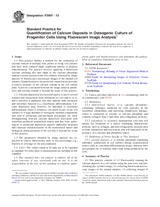
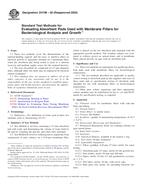 ASTM D4198-82(2011)..
ASTM D4198-82(2011)..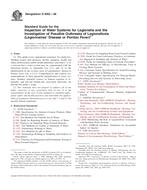 ASTM D5952-08
ASTM D5952-08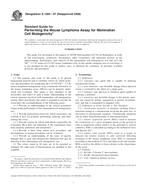 ASTM E1280-97(2008)..
ASTM E1280-97(2008)..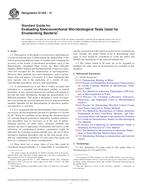 ASTM E1326-13
ASTM E1326-13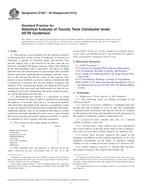 ASTM E1847-96(2013)..
ASTM E1847-96(2013)..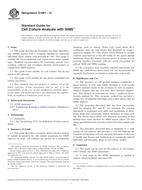 ASTM E1881-12
ASTM E1881-12
 Cookies
Cookies
